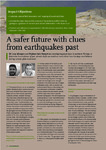A safer future with clues from earthquakes past
| dc.contributor.author | Menegon, L | en |
| dc.contributor.author | Stewart, I | en |
| dc.date.accessioned | 2022-02-08T12:38:00Z | |
| dc.date.available | 2022-02-08T12:38:00Z | |
| dc.date.issued | 2019-12-01 | en |
| dc.identifier.issn | 2398-7073 | en |
| dc.identifier.uri | http://hdl.handle.net/10026.1/18682 | |
| dc.description.abstract |
<jats:p>Understanding the short- and long-term mechanical behaviour of the lower crust is of fundamental importance when trying to understand the earthquake cycle and related hazard along active fault zones. In some regions some 20% of intracontinental earthquakes of magnitude > 5 nucleates in the lower crust at depth of 30-40 km. For example, a significant proportion of seismicity in the Himalaya, as well as aftershocks associated with the destructive 2001 Bhuj earthquake in India, nucleated in the granulitic lower crust of the Indian shield. Earthquakes in the continental interiors are often devastating and, over the past century, have killed significantly more people than earthquakes that occurred at plate boundaries. Thus, a thorough understanding of the earthquake cycle in intracontinental settings is essential. This requires knowledge of the mechanical behaviour and of the strength (by which Earth scientists commonly mean the maximum stress that rocks can sustain before deforming) of the lower crust. The most common conceptual model of the strength of the continental crust predicts a strong, seismogenic brittle upper crust (where the base of the seismogenic layer is typically considered to be at depth of 10-15 km), and a weak, viscous, aseismic lower crust. This model has been recently questioned by the finding that the lower crust can be seismic and, therefore, mechanically strong. The question arises, how thick is the seismogenic layer in the crust? Answering this question is crucial to determine the potential hazard caused by large earthquakes, which are also generally the deepest.<br/> Our limited knowledge of the mechanical behaviour of the lower crust is largely due to the lower crust itself being poorly accessible for direct geological observations, so that most of our knowledge derives from indirect geophysical measurements (like the distribution of earthquakes). There are only a few well-exposed large sections of exhumed continental lower crust in the world. One of these is located in the Lofoten islands (northern Norway), which were exhumed from their original deep crustal position during the opening of the North Atlantic Ocean.<br/> We propose an integrated, multi-disciplinary study of a network of brittle-viscous shear zones (i.e. zones of localized intense deformation of geological materials) from Lofoten, which records episodic rapid slip events (earthquakes) alternating with long-lasting aseismic creep. The study will link structural geology (analysis of geological faults and shear zones), petrology (analysis of the composition and textures of rocks), geochemistry (detailed chemical characterization of rocks and minerals) and experimental rock deformation (to reproduce in the lab under controlled conditions the deformation processes operative in the deep Earth's crust). This integrated dataset will provide a novel, clear picture of the mechanical behaviour of the continental lower crust during the earthquake cycle. Our direct geological and experimental observations will be tested against geophysical observations of currently active seismic deformation. The cumulative results of the projects will shed light on the currently poorly constrained mechanical behaviour of the lower crust during the earthquake cycle, and therefore on the sequence of inter-seismic slip (the period of slow accumulation of elastic deformation along a fault), co-seismic slip (the sudden rupture along a fault that is the earthquake) and post-seismic slip (the immediate period after an earthquake when the crust and the fault adjust to the modified state of crustal stress caused by an earthquake). This will greatly extend and complement existing efforts by the scientific community to understand and interpret the mechanical behaviour of rocks during the earthquake cycle recorded in the lower crust and the related hazard, and will provide key input for numerical models of continental dynamics.</jats:p> | en |
| dc.format.extent | 6 - 8 | en |
| dc.language | en | en |
| dc.language.iso | en | en |
| dc.publisher | Science Impact, Ltd. | en |
| dc.title | A safer future with clues from earthquakes past | en |
| dc.type | Journal Article | |
| plymouth.issue | 9 | en |
| plymouth.volume | 2019 | en |
| plymouth.journal | Impact | en |
| dc.identifier.doi | 10.21820/23987073.2019.9.6 | en |
| plymouth.organisational-group | /Plymouth | |
| plymouth.organisational-group | /Plymouth/Faculty of Science and Engineering | |
| plymouth.organisational-group | /Plymouth/Faculty of Science and Engineering/School of Geography, Earth and Environmental Sciences | |
| plymouth.organisational-group | /Plymouth/REF 2021 Researchers by UoA | |
| plymouth.organisational-group | /Plymouth/REF 2021 Researchers by UoA/UoA07 Earth Systems and Environmental Sciences | |
| plymouth.organisational-group | /Plymouth/Research Groups | |
| plymouth.organisational-group | /Plymouth/Research Groups/Marine Institute | |
| plymouth.organisational-group | /Plymouth/Users by role | |
| plymouth.organisational-group | /Plymouth/Users by role/Researchers in ResearchFish submission | |
| dcterms.dateAccepted | 2019-11-20 | en |
| dc.rights.embargodate | 2022-02-12 | en |
| dc.rights.embargoperiod | Not known | en |
| rioxxterms.versionofrecord | 10.21820/23987073.2019.9.6 | en |
| rioxxterms.licenseref.uri | http://www.rioxx.net/licenses/all-rights-reserved | en |
| rioxxterms.licenseref.startdate | 2019-12-01 | en |
| rioxxterms.type | Journal Article/Review | en |


